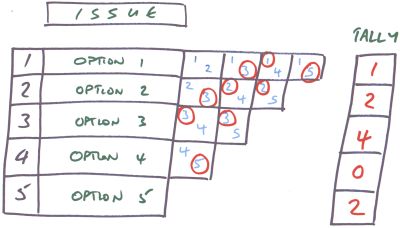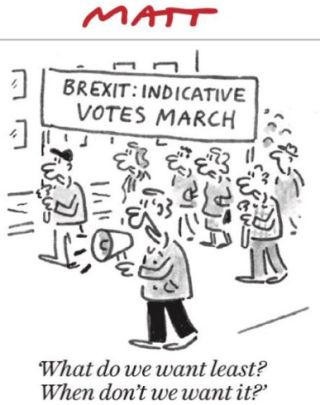Indicative Votes from Forgotten Paired Comparison Tool

Another way you can leverage the blanket media Brexit coverage. Thankfully, one you can deploy without taking sides. Nicely avoiding the problematic alienation of half your audience.
When spin creates so many different options, where no single one garners a 50-percent-plus-one majority, how on earth do you coalesce behind a winner?
It is rare I’m reminded of Total Quality Management. A Classic Fad. Huge late-Eighties, early-Nineties, TQM played hysteric gigs to sold-out stadiums everywhere it went.
Although no longer on top of playlists, perhaps subsumed in part within the likes of ‘six sigma’ et al, TQM’s underlying themes remain key to many organisations without them probably knowing.
Yet one of their protagonists’ favoured tools is in vogue here.
Indicative votes. Yet another new(ish) phrase Brexit gifts the world.
Legislative democracy is centred around the passing of motions where there is a binary choice. The classic Yea or Nay. Very occasionally, this may get put to one side. Where a list of choices each garners Noes, for instance, with nothing ever getting selected. Britain’s Parliament appears in this place as I blog. Where art thou Ayes…
Indicative votes may (may) provide a path forward.
With the advent of reality tv, journalists feel they are being helpful by explaining these using the example of how contestants are voted off your favourite talent-survival-entertainment show.
Imagine your prospect’s wishlist could go through a system of indicative votes. Which might fly highest?
The knowledge you learn may be priceless.
So how ought you frame such an exercise?
Paired Comparisons.
Can it really be so simple as drawing out a grid and pitting each available pair against each other in rotation?
The image up top is how I once summed this up ‘in print’. Way back at the turn of the century. When it was quite vogue to ape those magazine style ‘tournaments’ for things like world champion crisps, leading to a patriotic tear of joy when a bag of ready salted beat off Pringles and Doritos. I accompanied my chart with this brief:
PAIRED COMPARISON
A way of comparing options when judged against one particular criteria:
Decide your key criteria (usually something to do with speed, disruption or money).
Write out each solution open.
Split out every available pairing.
In each pairing decide which closest matches your over-riding criteria.
Tot up each option’s ‘wins’ from each ’bout’.
Assign priorities on the basis of most wins.
This can be another great objective method when completing the exercise ‘blind’ and you add up the scores at the end.
I note with interest the evolution of this. Which leads to a different style of grid construction.
Mindtools and Toolshero both show that nowadays you might also apportion scores to the level of ‘victory’. In their case using percentages. Can you do similar to at least understand the real options on the table, and best, uncover the true buyer preferences?

